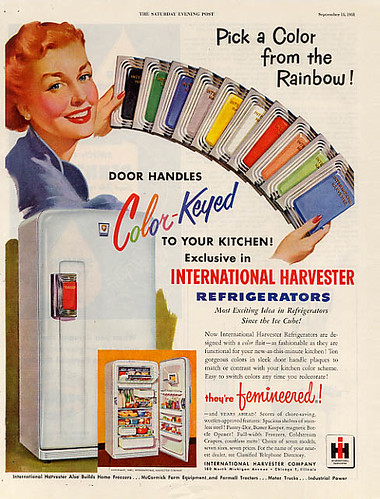


After the war, businesses expanded rapidly and the economy skyrocketed. Industrial jobs became less common, and more people worked in higher-paying jobs usually in sales or advertising. Franchises began popping up around the country- McDonald's, for example, was one of the most successful franchises of the time and today it is also the largest. The significance of these franchises was that they helped to standardize what people ate. The 50s was also a conformity movement, and in ways besides their diet, American lives were being more and more standardized. A loss of individuality had to be paid in exchange for economic advancement. In the business world, there was no room for creativity.
Another theme during the era was the exploding population, commonly called the "baby boom". When soldiers returned home, they settled into family life again. During the 50s, there was a large emphasis on marriage and family, especially for women. Men were back in the work force, and women became homemakers once again. The American dream of the 1950s was: single-family home in the suburbans, safe healthy environment for children with good schools nearby, and jolly neighbors all around. The dream house also had all the latest technology in household appliances, so that the woman who stayed at home all day would have to do less work and she could be happier and livelier. Less work meant more leisure time, and during the 50s Americans had more of that than ever before. With more vacation time, automobiles played a significant role in the 50's lifestyle. Now not just a commodity, cars even had their own style. Many of them were marketed for fashion and fun. With the automobile came drive-thru at franchises, and franchises meant consumerism. Buy, buy, buy became the mentality all around the media and at home.
Although the 1950's were all about conformity, youth rebelled stronger than ever. They shaped the pop-culture movement during this time: for the first time ever teens dressed differently from their parents and they listened to different music. Rock and roll started as a trend among youth but grew unto older generations as well. These youth moved on into the 60's to create the decade which became the rebuttal of the 50's: the era of non-conformity.
by Mingming

3 comments:
Well written. I really liked the Mcdonalds picture, as well as the female stereotypes in the appliance advertisement. Good job.
I really like the pictures that you used. The article was well written and very informative. Good job!
I really like the way you mentioned both the fact that adults were conforming, and that kids wanted to rebell
Post a Comment